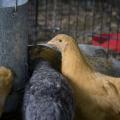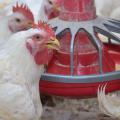Frequently Asked Questions
What poultry project opportunities are offered to 4-H youth?
Many activities are available to the 4-H youth interested in a poultry activity. Activities include the raising of poultry to produce meat or eggs and the entry of the records in a competition with other 4-H poultry projects. Several judging and demonstration contests are available including junior and senior Poultry Judging Contests, Egg Preparation Contests for seniors, Visual Presentations and Chicken Barbecue Contests for junior and senior age youth. Winners at the state level can continue competition in nationwide contests. More details in these activities can be obtained by referring to the 4-H Poultry Leader Guide or any of the publications directed toward a specific activity.
I have show birds that I want to exhibit. How do I get them ready?
Four-H members expecting to make creditable showings in poultry shows must prepare their exhibits prior to show time. Birds not properly selected and prepared for the show will not, as a rule, get very far in a competitive show. Good exhibits stand out and are a credit to the exhibitor. See Selecting and Preparing Birds for Exhibition.
How do I care for newly hatched chicks?
A series of short newsletters are available for the novice who is caring for chicks for the first time. The newsletters are easily read and are arranged in sequence from preparing of the facilities until the birds mature. Refer to the publication Grow Healthy Chicks for basic information on caring for growing chicks.
How are Chicks Brooded?
The day-old chick's temperature is about 3° F below that of an adult's. Its body temperature starts rising about 4 days of age and reaches its maximum at 10 days. The chick needs time to develop temperature control (2 to 4 weeks). As the chick grows older, the downy coat is replaced with feathers, and brooder temperature must be reduced according tothe temperature schedule.
Brooding Temperature Schedule |
|||
| Age, days | Brooder temperature | ||
| °F | |||
| Summer | Winter | ||
| 1-7 | 90 | to | 95 |
| 8-14 | 85 | to | 90 |
| 5-21 | 80 | to | 85 |
| 22-28 | 75 | to | 80 |
| 29-35 | 70 | to | 75 |
| 36 to market | 70 | ||
Under this brooding schedule, the brooding temperature is reduced 5 °F each week. At 5 weeks of age, chicks maintain their own body temperatures if the room temperature is kept near 70 degrees.
Use lower brooding temperatures during warm months. Most poultry houses are not tight enough to maintain these temperatures constantly in winter. Insure adequate warmth in winter by using the higher brooding temperature; when cold nights cool the house, chicks are likely to have enough warmth.
In contrast to what many think, the most frequent error observed when brooding in the South is overheating rather than too little heat. Many producers need to learn proper brooding to reduce losses.
Check the comfort of the chicks several times each day, especially in the evening. Make adjustments to maintain chick comfort. Contented peeping and even distribution of chicks around and under the brooder indicate comfortable conditions. If the chicks chirp and huddle to one side of the brooder, there is a draft. When the temperature is too cold, the chicks chirp sharply and huddle together under the brooder. If the chicks move away from the brooder, pant, and are drowsy, the temperature is too warm.
Are there any suggested exhibits for science projects that involve the incubation of chicken eggs?
Publications
News
Farm supply stores are full of cute chicks in the spring, and the sight of the fluffy baby birds, combined with future dreams of fresh eggs, prompts many people to impulsively start a backyard flock.
STARKVILLE, Miss. -- Keeping buffalo wings on menus is a supply chain issue that goes all the way back to procedures farm workers follow to protect the health of commercially grown chickens.
Baby chickens are so cute and cuddly that few people can resist holding them. Unfortunately, as public interest in raising backyard birds has grown so has the number of Salmonella outbreaks in the U.S. (Photo by Centers for Disease Control and Prevention)
Success Stories
When Becky Baker enrolled her three children in 4-H, her main goal was to get them involved in the public speaking program.
Children who enjoy hands-on learning and want to showcase their accomplishments and compete against fellow participants can join the 4-H Poultry Chain Project.
The 4-H Poultry Chain Project regularly receives generous donations from organizations across the state, but the project has never received a donation quite like Southern AgCredit’s pledge of $25,000 over 5 years.










